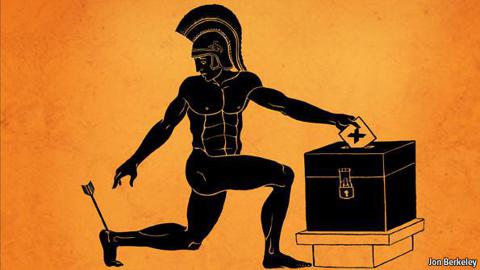The young man was a sophomore in college. It was summertime. But was he out working or looking for a job? No. He was reclined on the bed eating Reese Cups. His father approached.
A Friendly Father and Son Talk
“What are you doing? You should be out looking for a job. When I was your age, we worked our way through college with summer jobs. Get out and get a job in seven days… or else.”
The “or else” was not specified but was uttered with a vehement voice full of dark consequences.
Five days later the father walked back into his son’s room on a bright, warm, summer day—a perfect day to be outside performing manual labor and getting paid for it; but his son was asleep, yes asleep. The father began the ignition sequence that rivaled a space-shuttle launch, but then… something caught his eye from across the room.

To his astonishment, he saw a big stack of bills—greenbacks, bucks, real money. Not minimum-wage kind of money. The father, suspecting some drug-dealing or criminal skullduggery, reached down and levitated the young man off of his bed in one fell swoop. A near-death experience was impending for the young man.
“What?” squealed the son.
The father held up the stack of bills. “Where did this money come from?”
“Oh, that. I sold a character.”
“What?”
“You told me I had to work. I created a gaming character with some superhero special skills for an online game. That’s my cut after my broker took his 10 percent. It’s $4,000.”
“How long did that take?”
“One week.”
Then it sunk in. His boy was an entrepreneur; forced to be one because he abhorred physical work and low wages. He had created and developed computer characters and sold them. Online, imaginary characters with superhero skills for an imaginary world in which his friends immersed themselves. And, he made more in one week than many people make in a month.
“Ok. I guess that’s acceptable. You can work at home.”
“Thanks, and Dad, you know when you said that when you were young you could work your way through college working during the summer? Well, I did the math. If I could make $36,000 in two months during the summer, why would I want to go to college?”
The yearly tuition for the university that he was attending was $36,000. The young man went on by saying,
“And, I wouldn’t have to take out student loans. You know Jimmy, our neighbor who graduated two years ago with a law degree? He told me he has $75,000 in student loans and can’t find a decent job. He’s delivering pizzas now.”

Well, aren’t you just Mr. Smarty pants, college kid. Have you ever watched Tucker and Dale vs. Evil?
The young man’s logic was unassailable.
I know this story because that father was me. The young man is my son. But that story begged the question, why does college cost so much now?

What Happened?
In 1975, the College Entrance Examination Board estimated the average total cost of a four-year public college at $2,679 a year ($11,852 in 2014 dollars). The average total cost of a private college: $4,391 ($19, 420 in 2014 dollars). Fast forward to the 2012-2013 school year. According to the Bureau of Labor Statistics, the average first-year, on-campus tuition for a public and an in-state public school was $21,700, and for a four-year private school was $43,000. That takes the price of a four-year degree to between $85,000 and $215,000 in tuition alone, without room, board and incidentals.
Why?
Why does college cost so much, and what does it mean for our future? The answers to those questions are the reason I co-wrote and edited Margins and Missions… Not Moonshots: Pathways to Better U.S. Higher Education. And those questions can be answered with one word, “mission.”
The Mission?
What is the purpose of higher education? Is it to prepare people for jobs? Prepare them to be critical thinkers? Or, prepare them to be better citizens and students of the world?
From my perspective, it’s to prepare the next generation to move humanity forward; to improve the world. To do that, you have to give intellectual, social and moral instruction to the student, which includes learning how to think critically and developing relevant job skills for today’s employment opportunities. But it’s much more than that. It’s also preserving and protecting current knowledge while creating new knowledge. To quote MIT’s Shigeru Miyagawa[1],
“New knowledge to share and bring to bear against the big problems of the world.”
Losing Focus Costs a Lot
Loss of mission focus is one of the main reasons why college costs so much. According to the 2014 American Association of University Professors Report, Losing Focus[2], from 1978 to 2014, administration positions rose by 369 percent while, during the same period, full-time tenure and tenure-track positions increased by just 23 percent.
Administrators don’t teach. A core mission focus for any higher-education organization is teaching.
Regulation
In fairness to higher-education institutions, a big part of this increase in administrative personnel is driven by government regulations. For example, the special report Compliance at Hartwick College[3] found that it was regulated by 28 federal agencies, 15 state agencies, four local governments and seven accrediting agencies. They identified 247 compliance items that are requested by 36 different entities. This not only requires but also demands, additional personnel and resources.
According to the Hartwick study, the annual cost of all compliances for the College, a small liberal arts school in upstate New York with only 1,500 undergraduates, totaled $297,000, and that’s a small school.
Higher Education Recreation Arms Race
Much of this increase, however, is self-inflicted. How? Former Labor Secretary, Robert Reich, commenting on why colleges cost so much, in the US News Today article “Why Does College Cost so Much?” stated:
Part of the problem stems from schools spending money on unnecessary campus amenities to attract students—building student unions and athletic facilities that “resemble country clubs.”
Could Reich be right? A cursory look on many American campuses will reveal perks like rock-climbing centers, lazy river rides, outdoor pools with massive video screens, free movie theaters, on-campus steakhouses, ice cream parlors, massage centers, even water parks, just to mention a few of the latest perks. Did you get that? Water parks?
According to NIRSA, the National Intramural-Recreational Sports Association, 92 schools reported over 1.7 billion in new recreational capital projects in 2013. How does that help educate the next generation to move humanity forward? Or prepare them for a job or career? It doesn’t. However, it does get the student used to unrealistic spectacular amenities and lifestyles that are subsidized by student-loan debt, which is painless until they leave school.
In what college are athletics and recreation a core mission? Higher-education leaders, in the guise of branding and marketing efforts, say they need these amenities and perks to compete with other institutions to attract and retain the best and brightest. A few institutions can successfully pull this off, but many can’t. This dilutes mission focus and escalates costs. Worse? It causes the very heartbeat of our future (the young students) to take on unconscionable amounts of debt to get a degree from these institutions; debt that will shackle and enslave them for years to come. Some for a lifetime.
Have Costs Really Risen that Much?
A small-business friend of mine, suffering from rapidly rising costs to insure his employees, disagreed with me on the cost of higher education.
Costs haven’t really risen that much over the years compared to other industries. For example, medical-care costs have increased outrageously in comparison to higher-education costs in the same timeframe. I know. I live it every day.
A 1,122 Percent Increase

That perception is out there. Costs have risen, but not that much in comparison to other industries, especially medical-care costs.
That perception is wrong. According to the National Center for Education Statistics[4],
- The price of college tuition (indexed) and fees have exploded by more than 1,122 percent since 1978.
- The cost of medical care rose less than 600 percent in that same timeframe.
- The cost of an undergraduate degree is 12 times higher than it was in 1980.
Costs have increased dramatically. It’s inarguable. But it’s also inarguable that the successful future of not only America but humanity itself is built on the foundation of education. A college education is costly, but it also changes your life forever. Whether you’re a doctor, an engineer, a scientist, a police officer or a business owner, education moves you forward through life—economically, socially and (hopefully) morally.
Student-Loan Debt
Access to a college education depends on affordability for the majority of Americans. But with costs so high, how do you pay for college? Student-loan debt—a lot of it.
That’s why out of 71 percent of all students graduating in 2013, 1.3 million carried approximately $33,000 in debt[5]. Student-loan debt (as of 2014) exceeds $1.2 trillion. It has more than tripled since 2004, is more than all of the U.S. credit-card debt combined and is the highest form of consumer debt second only to mortgages. This debt ends up being long-term, and on average, it takes:
- 20 years to pay off undergraduate-degree loans and
- 23 years to pay off graduate-degree loans
The Demons of Debt
During the writing of the book ““Margins and Missions… Not Moonshots: Pathways to Better U.S. Higher Education,“ I spoke with many recent college graduates. Almost all (except students from wealthy families) were shackled with out-size, long-term student debt. Many had monthly payments of over $1200. That’s equivalent to the payment of a nice three-bedroom house in the Midwest. Many were not working in their desired field or making the salary they expected because of the recent economic maelstrom and recession. But that debt is still there. Those payments, though they can be deferred, do not go away. They stifle, they suffocate, and they metastasize.
When the baby-boomers got out of college, they had very little student-loan debt. They went to work, moved out from their parents’ home, rented apartments, bought cars, started families and purchased houses. That consumption helped fuel the growth of the U.S. economy.
Student-loan debt seriously curtails new and recent graduates from doing the same. The rate of home ownership is 36 percent less among those currently repaying student debt, according to the One Wisconsin Institute[6], and their data suggest that student-loan debt reduces new-vehicle spending in the U.S. by $6.4 billion yearly. Student debt also diverts funds away from retirement, new-business startups, and other consumer purchases
People with serious student-loan debt also struggle emotionally and socially. Here are a couple of comments from people I spoke with:
I met the girl of my dreams. What’s she going to think when she learns I have $100,000 in student loans? That’s a long-term noose around my neck. Will she dump me? I would if I were her.
and
I’m 35 years old, and over half of my monthly pay goes to student-loan debt. I’m never going to be able to afford a house or a car.
Student-loan debt has driven people to contemplate and even commit suicide. In C. Cryn Johansen’s article, The Ones We Lost: The Student Loan Debt Suicides[7], she chronicles several heartbreaking student-loan-debt-inspired suicides. People heavily indebted with no jobs or low-paying jobs who see no light at the end of the tunnel. They see no way ever to work their way out of debt. It crushes them.
A Stark Reality – the Dark Demons of Debt

The American future depends on pursuing the American dream. That American dream is fueled by and built on education—especially higher education. But access to higher education depends on affordability. College is not affordable for the average American family. It costs too much. The only way to gain access for most is student-loan debt. If student loans weren’t available, over 70 percent of Americans would not be able to attend college. Access would be limited to only the very wealthy and the elite few that earned scholarships and grants enough to pay for it.
The extreme amount of current student-loan debt shackles and enslaves people for decades. Instead of pursuing the American dream, these student-loan debt holders become economic slaves with their future potential being sucked out by the dark demons of debt. Their consumption power—the ability to buy houses and cars, start businesses and other consumer purchases—cannot fuel future economic growth for America because a great deal of that money goes directly back to the banks.
These dark demons of debt are the Achilles heel of a growing, thriving American economy.
The Solution?
I’m writing this as a parent. A parent concerned for this and future generations. When I see a truck barreling down the road and getting ready to run me over, I’m savvy enough to get out of the way. The student-loan truck loaded with demons of debt and dire consequences is barreling down the road at all of us.
What can we do now to start fixing things?
The Simple Answer
Cut costs. Lower tuition. Reduce student loan borrowing. There. Problem solved. Simple, right?
For every complex problem, there is an answer that is clear, simple and wrong.
– H. L. Mencken
The answer is simple; getting to the answer is the problem.
It’s a Little Stickier Than That

These issues—accessibility, affordability, and debt—are a complicated web of intricately linked issues that have to be addressed with a fierce, focused, multi-pronged attack, much like cancer or the Ebola virus. First you isolate and contain, then treat, ameliorate and finally eradicate … as much as possible.
During the writing of this book, I had the opportunity to speak to many higher-education and business leaders. Some of the best and brightest. Many pointed to possible solutions to the student-loan and college-affordability problem. Here are some solutions that seem to have immediate and impactful potential.
Debt: Loan Forgiveness
The Public Service Loan Forgiveness Program[8] is intended to encourage people to enter and work full time in public-service jobs. People in the program may qualify for “forgiveness of the remaining balance of their Direct Loans after they have made 120 qualifying payments on those loans while employed full time by certain public-service employers.”
But why only public-service employees? Who pays for that forgiveness? The taxpayers and private enterprise of course. What’s good for the goose is good for the gander. The government is supposed to be of the people, by the people and for the people, not of the people, by the people and for the government people. This program should apply to all people in student-loan debt programs. If you are employed and make 120 qualifying payments on your Direct Loans, the remainder of the balance should be forgiven. I suspect that taking this action would also substantially change student-loan debt issuance.
Debt: Loan Refinancing
Current student-loan financing terms are all over the place. In many instances, student loans cannot be refinanced, and people are stuck with high-interest rates. This is unconscionable. We must do everything we can to help people who are shackled by these high rates and high payments. It’s a drag on the economy, and it affects everyone—except the banks.
Senator Elizabeth Warren of Massachusetts has an idea to address this issue. Her bill, S. 897, wants the Federal Reserve System to give student-loan borrowers the equivalent to the interest rates at which the federal government provides loans to banks through the discount window operated by the Federal Reserve System. That rate currently (2014) is less than one percent (0.75%). This would make a drastic difference to cash flow for student-debt loan holders.
Debt: Radical Loan Forgiveness
Another option is a radical reset. Wipe out all student-loan balances and start from scratch. The government bailed out the banks from collapse in 2008, so why can’t they do it for the student-loan victims? It’s radical no doubt, and it needs study. But, think about it—what do you think would be the impact of freeing up people with draconian student-loan payments? They would start purchasing houses, cars, other products and assets and even start new businesses.
Is this a good idea? Not sure. But can you see the possibilities? Maybe even a variation of this radical approach by forgiving portions of the debt for some types of purchases. For example, a 2013 housing-market survey by the National Association of Realtors (NAR) found that nearly half of all surveyed cited student-loan debt as “a huge obstacle to home ownership.” One Wall Street firm recently proposed that a large portion of someone’s student-loan debt could be forgiven if the person purchased a house. That would change the debt into a productive form of debt instead of a destructive drag on the economy. Surely there are some smart, innovative financial thinkers out there who can solve this issue.
Debtor’s Prison or Bankruptcy?
Under the current federal law, federal and/or private student loans cannot be discharged in bankruptcy. Banks love this. They say it keeps interest rates low. But for some people, it traps them in lifelong debt with no chance to ever dig their way out.
It’s the modern-day equivalent of a debtor’s prison.
Senator Tom Harkin, Chairman of the Senate panel on education, proposed H.R. 3892 in the 113th Congress (2013-2014), which removes educational loans from the list of debts that are non-dischargeable in bankruptcy. This would also bring sanity back into the loan process. Loans would be looked at closer if the banks knew that there was a risk of them not being paid back.
That is common sense.
Cost: Tuition Free
Germany now offers free tuition to all students—national and international. Why? Mainly because they think it is socially discriminatory to charge tuition. Dorothee Stapelfeldt, a Hamburg senator, said that tuition fees were “unjust” and that “they discourage young people who do not have a traditional academic family background from taking up study. It is a core task of politics to ensure that young women and men can study with a high-quality standard free of charge.”
This, of course, seems desirable but almost too good to be true.
However, there is a significant difference between German and American universities. German universities don’t have all of the perks, amenities, and recreational options that some American institutions do—some might say that “…you have to work in school to get a degree, not lounge around in water parks watching movies.”
Germany isn’t the only country, though. Finland, France, Sweden, Norway, Slovenia, and Brazil offer free or almost free tuition for students—even Americans.
MIT’s OpenCourseWare and Intellectual Philanthropy

I’m an advocate of MIT’s OpenCourseWare and its mission of Intellectual Philanthropy. OCW has power, resources, and presence to make a real difference in the world.
OCW publishes virtually all MIT course content and makes it widely available (mostly free) to the world as a permanent MIT activity that they call “Intellectual Philanthropy.”
At this writing, MIT OCW, which is one of the most widely used educational resources on the Web, has:
- 2206 courses online
- 602 MIT faculty contributing
- Over two-million visitors per month
- 10.3 million monthly page views
- Over 200-million visitors since inception.
Over the past ten years, the program has generated some dramatic usage numbers, including:
- 43.5 million iTunes lecture video downloads
- 48.6 million YouTube lecture video views
- 18.5 million downloads of course-content .zip files.
A voluntary effort of the MIT faculty, OCW is one of the largest intellectual philanthropy efforts ever by a higher-education institution. The OCW site includes materials from five Nobel Prize winners and 44 MacVicar Fellows—professors who are recognized by the Institute for their outstanding contributions to MIT undergraduate education.
The ability to access MIT courses is an amazing learning resource. The only downside is that enrollees don’t get credit for it… yet. Maybe someday. But, if you need to stay up with the latest and greatest in your industry—or ahead of it—this is the place to start, and you will incur no student-loan debt.
Continuing and never-ending learning is now the norm for our world. MIT OCW is the very first place that I check when I want to track down and learn “knowledge to bring to bear against the big problems of the world.”
The $10,000 Degree
The academic paper[9], “$1 Trillion and Rising: A Plan for a $10K Degree” by Anya Kamenetz, focuses on reducing the costs of a degree with a six-step plan to get to a quality $10,000 college degree. The steps include:
- Reduce non-teaching personnel and restructuring the use of teaching personnel.
- End the “perk wars” (already discussed in this chapter).
- Focus on graduation, not enrollment. Focusing on graduation completely changes the cost equation.
- Dramatically increase blended learning with the use of MOOCs, but also integrate these technologies to not only increase productivity but also to free up faculty to provide intensive, one-to-one teaching and mentoring.
- Streamline offerings and charging $10K for BAs in the top 10-12 fields of study. Eighty percent of undergraduates choose from approximately a dozen fields of study, yet a top-tier public university offers around 250 fields of study.
- Rethink the college architecture into smaller units. The paper suggests a framework of cohort colleges, adult online universities, flagship campuses and micro/popup schools.
While some of these suggestions may be controversial and radical, some are changes that are long overdue and would reap immediate results.
Having the great opportunity to perform, compile and edit many of the interviews in this book, some other ideas with great potential have surfaced. A few are listed below.
New Sources of Revenue—Universities need to find and free up new revenue streams instead of relying on tuition increases. Simplifying operational and institutional complexity issues alone could save hundreds of millions if not billions of dollars. Here’s one example. Colleges and universities invest $92 billion in research and IP and only generate a 1 percent return[10]. Surely we can do better.
Costs—A former president of Ohio State University once stated:
I readily admit it, I didn’t think a lot about costs. I do not think we have given significant thought to the impact of college costs on families.
An Entrepreneurial Mindset—We need to embrace an entrepreneurial mindset that’s focused on better serving students and fulfilling the core institutional mission. If an institution is run with an entrepreneurial mindset, there will be plenty of focus put on costs. Colleges and universities cannot deliver on their stated missions without margins, and there can be no margins without accountability and a business mindset.
Act Now—The time to act is now if we want to save the future of the U.S. higher education system. We need to help universities find and free up new revenue streams and resources, reduce support and administrative costs and streamline their complex organizations. Also, we need to embrace an entrepreneurial mindset that’s focused on better serving students and fulfilling the core institutional mission.
We can fix this. We must fix this. Our future depends on it.
###
This is an excerpt from a book I co-edited/co-authored titled “Margins and Missions… Not Moonshots: Pathways to Better U.S. Higher Education.“
Steven J. Kayser is an award-winning writer, former radio host, media relations director, and the author of “The Greatest Words You’ve Never Heard: True Stories of Triumph,”; and co-editor and author of “Margins and Missions… Not Moonshots: Pathways to Better U.S. Higher Education.”

Notes:
[2] http://aaup.org/reports-publications/2013-14salarysurvey
[3] http://www.naicu.edu/docLib/20130315_Compliance-HartwickColl-12-12.pdf
[4] http://nces.ed.gov/programs/digest/d13/tables/dt13_330.40.asp
[5] http://projectonstudentdebt.org/files/pub/Debt_Facts_and Sources.pdf
[6]http://www.onewisconsinnow.org/files/OWIStudentLoanEconomicReport.pdf
[7] http://www.huffingtonpost.com/c-cryn-johannsen/student-loan-debt-suicides_b_1638972.html
[8] https://studentaid.ed.gov/repay-loans/forgiveness-cancellation/charts/public-service#what-is-the-public
[9] http://content.thirdway.org/publications/751/_1_Trillion_and_Rising-_A_plan_for_a_10K_Degree.pdf
[10] http://www.bain.com/publications/articles/financially-sustainable-university.aspx




Recent Comments
Lessons Learned from Hollywood STORY Guru Robert McKee